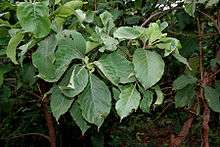Hymenodictyon
| Hymenodictyon | |
|---|---|
 | |
| Scientific classification | |
| Kingdom: | Plantae |
| (unranked): | Angiosperms |
| (unranked): | Eudicots |
| (unranked): | Asterids |
| Order: | Gentianales |
| Family: | Rubiaceae |
| Subfamily: | Cinchonoideae |
| Tribe: | Hymenodictyeae |
| Genus: | Hymenodictyon N. Wallich |
| Type species | |
| Hymenodictyon orixense ( Roxburgh) Mabberley | |
| Species | |
|
~ 30 species, see text | |
Hymenodictyon is a genus of flowering plants in the family Rubiaceae. It has about 30 species. [1] All are native to the Old World. The wood of Hymenodictyon orixense is soft and has limited use, mostly for boxes. [2] The type species for Hymenodictyon is Hymenodictyon orixense (synonym: Hymenodictyon excelsum). [3] [4]
Hymenodictyon was named by Nathaniel Wallich in 1824 in an addendum to William Roxburgh's Flora Indica, in an edition published by Carey and Wallich after Roxburgh's death. [5] [6] The generic name is derived from two Greek words, hymen, "membrane", and diktyon, "net". It refers to the wing that surrounds each seed. [7]
Molecular phylogenetic studies have shown that Hymenodictyon is paraphyletic over the Madagascan genus Paracorynanthe. [8]
In Hymenodictyon and Paracorynanthe, the stipules bear large deciduous glands called colleters. The corolla tube is narrow at the base, gradually widening toward the apex. The fruit is a woody capsule.
References
- ↑ Hymenodictyon At: World Checklist of Rubiaceae At: Kew Gardens Website. (see External links below).
- ↑ David J. Mabberley. 2008. Mabberley's Plant-Book third edition (2008). Cambridge University Press: UK. ISBN 978-0-521-82071-4
- ↑ Hymenodictyon In: Index Nominum Genericorum. In: Regnum Vegetabile (see External links below).
- ↑ David J. Mabberley. 1982. Hymenodictyon orixense, page 66. In: "William Roxburgh's 'Botanical description of a new species of Swietenia (Mahogany)' and other overlooked binomials in 36 vascular plant families". Taxon 31(1):65-73.
- ↑ Hymenodictyon In: International Plant Names Index. (see External links below).
- ↑ Nathaniel Wallich. 1824. Flora Indica; or Descriptions of Indian Plants 2:148. The Mission Press. Serampore, India. (see External links below)
- ↑ Umberto Quattrocchi. 2000. CRC World Dictionary of Plant Names volume II. CRC Press: Boca Raton; New York; Washington,DC;, USA. London, UK. ISBN 978-0-8493-2676-9 (vol. II). (see External links below).
- ↑ Ulrika Manns and Birgitta Bremer. 2010. "Towards a better understanding of intertribal relationships and stable tribal delimitations within Cinchonoideae s.s. (Rubiaceae)". Molecular Phylogenetics and Evolution 56(1):21-39. doi:10.1016/j.ympev.2010.04.002
External links
- Hymenodictyon At: Search Page At: World Checklist of Rubiaceae At: Index by Team At: Projects At: Science Directory At: Scientific Research and Data At: Kew Gardens
- Hymenodictyon At:Index Nominum Genericorum At: References At: NMNH Department of Botany At: Research and Collections At: Smithsonian National Museum of Natural History
- Hymenodictyon At: Plant Names At: IPNI
- Flora Indica At: Center for Study of the Life and Work of William Carey At: William Carey Uneversity
- CRC World Dictionary of Plant Names: D-L At: Botany & Plant Science At: Life Science At: CRC Press
- Hymenodictyon At: List of Genera At: Rubiaceae At: List of families At: Families and Genera in GRIN At: Queries At: GRIN taxonomy for plants